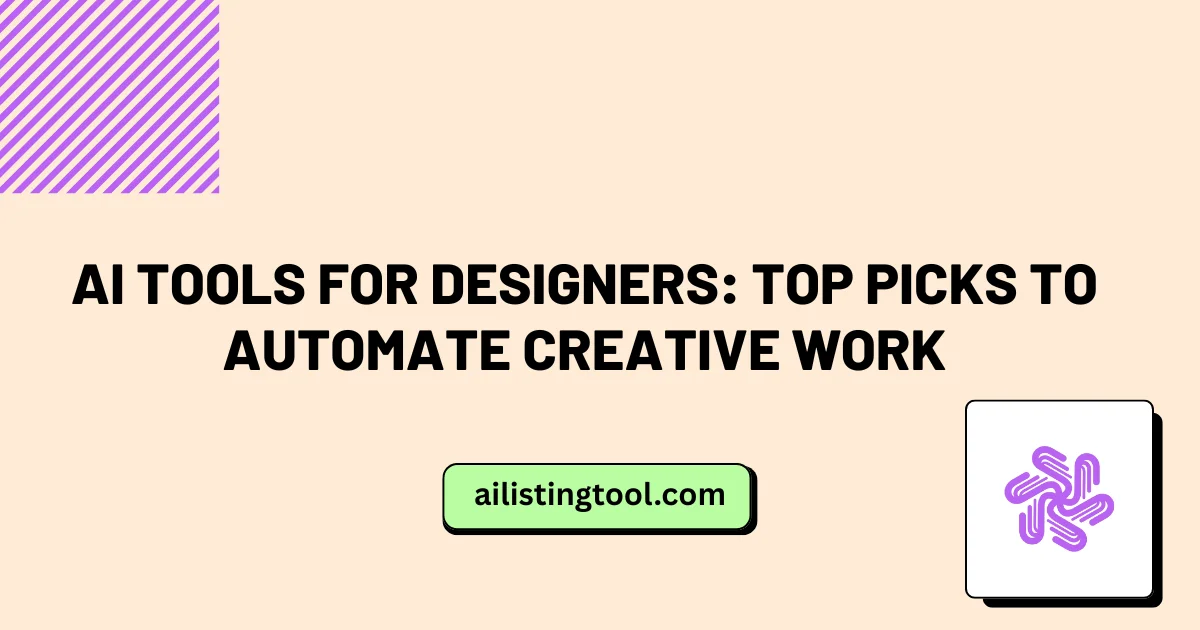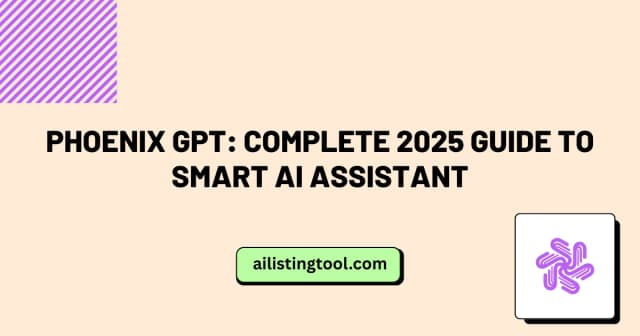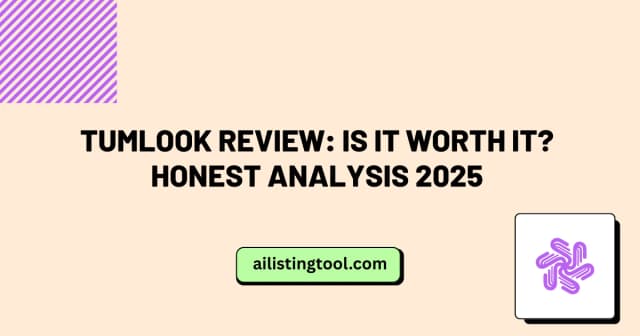AI Tools for Designers: Top Picks to Automate Creative Work

As a designer, you’ve probably felt the pressure of tight deadlines, repetitive tasks, and the constant demand for fresh, innovative visuals. Whether you’re creating social media graphics, refining product mockups, or experimenting with new layouts, the creative process can be time-consuming.
This is where AI tools step in to transform how designers work. Modern AI design tools don’t replace your creativity—they amplify it. They handle the tedious parts of design work, automate repetitive tasks, and help you explore new creative directions faster than ever before.
In this guide, I’ll walk you through the best AI tools for designers that are genuinely useful in real-world workflows. These aren’t just trendy apps—they’re practical solutions I’ve tested and analyzed based on how they solve actual design challenges. You’ll learn what each tool does best, when to use it, and how it fits into your creative process.
Why Designers Are Turning to AI Tools
The design landscape has shifted dramatically over the past two years. AI-powered tools have moved from experimental novelties to essential parts of professional workflows. Here’s why this shift is happening:
Speed and Efficiency AI tools can generate multiple design variations in seconds, cutting down the time you’d spend on initial concepts from hours to minutes. This means more time for refinement and creative thinking.
Handling Repetitive Tasks Tasks like background removal, image resizing, color palette generation, or format conversions can now be automated. This frees you to focus on the strategic and creative aspects of your projects.
Accessibility for Non-Technical Designers Many AI design tools require no coding knowledge or complex technical setup. You can achieve professional results without spending weeks learning new software.
Cost Savings Instead of hiring additional team members or outsourcing specific tasks like photo editing or illustration, AI tools provide affordable alternatives that deliver quality results quickly.
The key is understanding which tools genuinely add value to your workflow versus those that are just impressive demos. If you’re looking for comprehensive AI tools specifically designed for content creation, we’ve covered the top options in detail.
Best AI Tools for Designers: Detailed Breakdown
1. Canva AI (Magic Studio)
What It Does: Canva’s AI-powered features, collected under Magic Studio, include text-to-image generation, background removal, Magic Eraser, and intelligent resizing. It’s built directly into Canva’s familiar interface.
Best For: Social media designers, content creators, and marketing teams who need to produce high-quality visuals quickly without extensive design training.
Key Features:
- Magic Write generates on-brand copy for your designs
- Magic Expand extends images beyond their original boundaries
- Background Remover isolates subjects in one click
- Magic Design creates complete design templates from a simple prompt
- Smart Resize adapts designs across different platform formats automatically
Real-World Use Case: I’ve used Canva AI extensively for creating LinkedIn carousel designs. The Magic Design feature helped generate five different layout options from a single content brief, which I then customized. What would have taken an hour of template browsing took about 10 minutes.
Pricing: Free plan available with limited AI features. Canva Pro starts at around $13/month with full access to Magic Studio tools.
2. Adobe Firefly
What It Does: Adobe Firefly is Adobe’s dedicated AI image generation tool, now integrated into Photoshop, Illustrator, and Express. It focuses on commercially safe, ethically trained AI models.
Best For: Professional designers working on commercial projects who need confidence in licensing and intellectual property rights.
Key Features:
- Text-to-Image generation with style controls
- Generative Fill in Photoshop for seamless object addition or removal
- Generative Recolor for vector artwork in Illustrator
- Text Effects that transform typography into textured, stylized designs
- Template generation for quick project starts
Real-World Use Case: When working on product mockups, I used Generative Fill to add realistic environmental elements around product shots—plants, textures, and backgrounds that matched the lighting perfectly. This eliminated the need for expensive photoshoots or stock photo subscriptions.
Pricing: Included with Creative Cloud subscriptions. Standalone Firefly plans start around $5/month for 100 monthly generative credits.
3. Midjourney
What It Does: Midjourney is a powerful AI image generator accessed through Discord. It creates highly artistic, stylized images from text prompts and excels at conceptual and illustrative work.
Best For: Concept artists, illustrators, and designers who need inspiration, mood boards, or unique visual styles that push creative boundaries.
Key Features:
- Advanced prompt engineering for precise control over outputs
- Style references to maintain visual consistency across projects
- High-resolution outputs suitable for print
- Community gallery for inspiration and learning
- Regular updates with improved models and capabilities
Real-World Use Case: For a branding project requiring an unconventional visual direction, I used Midjourney to generate dozens of concept illustrations exploring different aesthetic approaches. These became the foundation for client presentations and helped secure buy-in for a bold creative direction.
Pricing: Basic plan starts at $10/month for limited generations. Standard plan at $30/month offers unlimited relaxed generations.
4. Runway ML
What It Does: Runway is an AI-powered video editing and generation platform that brings AI capabilities to motion design and video content creation.
Best For: Motion designers, video editors, and multimedia creators who want to integrate AI into video workflows.
Key Features:
- Text-to-Video generation for creating motion content from descriptions
- Frame Interpolation for smooth slow-motion effects
- Green Screen removal without physical green screens
- Style Transfer to apply artistic styles to video footage
- Inpainting for removing unwanted elements from video
Real-World Use Case: I used Runway’s Green Screen tool to create promotional videos without studio equipment. By filming against a plain wall, the AI accurately removed backgrounds and replaced them with branded environments, saving both time and production costs.
Pricing: Free plan with limited credits. Standard plan at $12/month includes 625 credits for various AI operations.
For designers working on video content, you might also want to explore Pictory AI’s text-to-video capabilities or Synthesia AI for free video generation.
5. Khroma
What It Does: Khroma is an AI color palette generator that learns your color preferences and suggests harmonious combinations tailored to your style.
Best For: Designers struggling with color decisions or looking to explore new palette directions while maintaining their aesthetic sensibilities.
Key Features:
- Personalized palette learning based on your selections
- Generates unlimited color combinations
- Provides accessibility ratings for text/background pairs
- Saves favorite palettes for later use
- Shows palettes applied to typography, gradients, and images
Real-World Use Case: When redesigning a brand identity, I trained Khroma on the client’s existing color preferences. It generated dozens of fresh palette options that felt aligned with their brand while pushing into new territory. This accelerated the exploration phase significantly.
Pricing: Free with optional premium features through one-time payment.
6. Remove.bg / Cutout.Pro
What It Does: These tools specialize in removing backgrounds from images with exceptional accuracy, powered by AI that understands complex edges like hair and transparency.
Best For: E-commerce designers, product photographers, and anyone frequently working with cutout images.
Key Features:
- One-click background removal
- Handles complex subjects including hair, fur, and transparent objects
- Bulk processing for multiple images
- API integration for workflow automation
- High-resolution downloads for professional use
Real-World Use Case: For an e-commerce client needing hundreds of product images isolated on white backgrounds, these tools processed the entire catalog in under an hour. Manual editing would have taken days.
Pricing: Free for low-resolution images. Subscription plans start at $9/month for 40 high-resolution images.
If you need more comprehensive photo editing capabilities, check out our guide on AI photo editors and free tools or explore Cutout.Pro’s complete feature set.
7. DALL-E / Stable Diffusion / Krea AI
What It Does: These are powerful text-to-image AI generators that create original images from written descriptions. Each has unique strengths in style, control, and output quality.
Best For: Designers needing custom illustrations, concept art, or unique visual elements that don’t exist in stock libraries.
Key Features:
- Text-to-image generation with detailed prompt control
- Image editing and inpainting capabilities
- Style transfer and artistic variations
- High-resolution outputs for professional use
- Iterative refinement through prompt adjustments
Real-World Use Case: When a client needed futuristic product visualizations that didn’t exist yet, I used these tools to generate dozens of concept images exploring different design directions. The AI-generated mockups helped secure project approval and guided the actual product development.
Pricing: Varies by platform. DALL-E offers credits-based pricing, Stable Diffusion has free and paid versions, and Krea AI offers flexible plans starting around $10/month.
8. ChatGPT for Designers
What It Does: While primarily a text-based AI, ChatGPT has become invaluable for designers needing help with copywriting, content strategy, brainstorming, and problem-solving.
Best For: Designers who handle both visual and written content, or who need assistance with client communications and project planning.
Key Features:
- Generates design briefs and project requirements
- Creates compelling copy for designs
- Helps with naming conventions and microcopy
- Provides design critique and improvement suggestions
- Assists with accessibility considerations and best practices
Real-World Use Case: When creating social media carousel content, I use ChatGPT to generate headline variations, body copy, and call-to-action text. It saves hours of copywriting time and often suggests angles I hadn’t considered.
Pricing: Free plan available. ChatGPT Plus at $20/month offers faster response times and access to advanced models.
For more detailed comparisons of AI writing tools, read our ChatGPT vs Jasper AI comparison guide.
9. Looka AI Logo Maker
What It Does: Looka uses AI to generate professional logo designs based on your brand preferences, style choices, and industry.
Best For: Designers working on branding projects, startups needing quick brand identity, or small businesses requiring professional logos without hiring an agency.
Key Features:
- AI-powered logo generation from brand inputs
- Customizable design elements and color schemes
- Brand kit creation with consistent visual identity
- Multiple format exports for various uses
- Instant mockups showing logos in context
Real-World Use Case: For a client launching multiple sub-brands quickly, Looka helped generate initial logo concepts in minutes rather than days. These AI-generated options became starting points that I refined into final deliverables.
Pricing: Logo packages start around $20 for basic files, with brand kit bundles available at higher price points.
Learn more about Looka’s AI logo maker capabilities or explore our roundup of the top logo makers and design tools.
10. Creatify AI
What It Does: Creatify AI specializes in creating video ads and marketing content using AI-generated visuals, voiceovers, and editing.
Best For: Digital marketers and designers creating ad content, social media videos, or promotional materials at scale.
Key Features:
- AI video generation from text scripts
- Automated voiceover with multiple voice options
- Template library for various ad formats
- Batch creation for A/B testing variations
- Direct integration with advertising platforms
Real-World Use Case: When testing different ad creatives for a product launch, Creatify helped generate 15 video variations with different hooks, visuals, and calls-to-action. This enabled comprehensive A/B testing that improved campaign performance by 40%.
Pricing: Plans start around $39/month with varying limits on video exports and features.
Explore Creatify AI’s complete feature set for more details on video ad creation.
How to Choose the Right AI Design Tool
With so many options available, selecting the right tool depends on your specific needs:
Consider Your Primary Design Tasks If you work mainly with static graphics for social media, Canva AI or Adobe Express might be sufficient. For more experimental, artistic work, Midjourney offers unmatched creative potential.
Evaluate Integration Needs Tools that integrate with your existing software save time. Adobe Firefly’s integration with Photoshop and Illustrator means no context-switching. Canva’s all-in-one platform eliminates the need for multiple tools.
Budget Constraints Start with free plans or trials to test functionality. Many tools offer generous free tiers that might meet your needs without requiring paid subscriptions.
Learning Curve Some tools like Canva AI are immediately intuitive, while others like Midjourney require learning prompt engineering techniques. Match tools to your available time for learning.
Licensing and Commercial Use For client work, ensure any AI tool you use provides clear licensing for commercial applications. Adobe Firefly and tools with transparent training data are safer choices for professional projects.
For a comprehensive overview of AI tools across different use cases, browse our complete AI tools directory.
Best Practices for Using AI Design Tools
Treat AI as Your Assistant, Not Your Replacement The best results come from combining AI capabilities with your design judgment. Use AI for initial concepts, variations, or tedious tasks, then refine outputs with your expertise.
Maintain Your Creative Voice Don’t let AI homogenize your work. Use these tools to speed up execution of your ideas, not to generate ideas wholesale. Your unique perspective remains your competitive advantage.
Always Review and Refine AI outputs often need adjustment. Check proportions, color accuracy, typography, and alignment. AI gets you 80% there—your refinement delivers the final 20% that makes work professional.
Learn Effective Prompting For text-to-image tools, investing time in learning how to write clear, detailed prompts dramatically improves results. Describe style, mood, composition, lighting, and specific elements you want.
Combine Multiple Tools No single AI tool does everything perfectly. Use Midjourney for concept generation, then refine in Photoshop with Firefly, and finalize layouts in Canva. Building a complementary toolkit yields the best results.
For more insights on optimizing your content creation workflow, check out our AI tools directory for marketers.
Common Mistakes to Avoid
Over-Relying on Default Settings Most AI tools offer customization options that dramatically improve outputs. Explore settings, adjust parameters, and experiment beyond default configurations.
Ignoring Licensing Concerns Not all AI-generated content is safe for commercial use. Research each tool’s terms of service and training data sources before using outputs in client work.
Skipping Human Review AI can produce technically correct but contextually inappropriate results. Always review outputs for accuracy, appropriateness, and alignment with project goals.
Using AI-Generated Content Without Attribution Where Required Some tools and contexts require disclosure of AI involvement. Stay transparent with clients and audiences about AI usage in your workflow.
Additional AI Design Resources
Beyond the core design tools mentioned above, consider exploring these specialized categories:
Video Editing: Browse our video editing AI tools category for more options like Veed.io, Fliki AI, and Haiper AI.
Image Generation: Explore our images category featuring tools for various visual creation needs, including Ghibli Art AI Generator for anime-style artwork.
Animation: Check out the animations category with tools like Paper Animator and Autodraft AI.
Content Creation: Visit our content generation category for AI tools that help with various creative content needs.
The Future of AI in Design
AI design tools continue evolving rapidly. We’re seeing improvements in understanding context, maintaining style consistency across projects, and generating more sophisticated outputs. Future developments will likely focus on:
- Better integration between different creative tools
- More personalized AI that learns individual designer preferences
- Enhanced collaboration features for teams using AI
- Improved accessibility features making professional design more inclusive
- Real-time generation that responds instantly to design adjustments
The designers who thrive will be those who adapt these tools strategically, maintaining their creative vision while leveraging AI for efficiency and exploration.
Stay updated on the latest developments by following our blog and exploring new AI tool launches.
Conclusion
AI tools for designers aren’t about replacing creativity—they’re about removing friction from the creative process. By automating repetitive tasks, accelerating concept generation, and expanding what’s possible within tight deadlines, these tools free you to focus on what you do best: thinking creatively and solving design problems.
Start by experimenting with one or two tools that address your biggest workflow pain points. As you become comfortable, expand your toolkit to cover more aspects of your design process. The investment in learning these tools pays dividends in saved time, expanded capabilities, and reduced stress.
The best AI design tool is the one that fits seamlessly into your workflow and genuinely makes your work better, faster, or more enjoyable. Try several, keep what works, and don’t be afraid to abandon tools that don’t deliver value for your specific needs.
Want to discover more AI tools? Submit your own tool to our directory or browse our comprehensive AI tools listings to find the perfect solutions for your creative workflow.
Found this helpful? Share it with others who might benefit!
The Premier AI Tools Directory for Global Visibility
AIListingTool connects AI innovators with 100K+ monthly users. Submit your AI tool for instant global exposure, premium backlinks & social promotion.
Submit Your AI Tool 🚀Related Articles

Phoenix GPT: Complete 2025 Guide to Smart AI Assistant
Artificial intelligence has transformed the way people communicate, work, and solve problems. Among the various AI tools available today, Phoenix GPT stands out as a conversational assistant designed to feel more human, intuitive, and accessible than traditional chatbot systems. Unlike rigid command-based interfaces that require users to adjust their communication style, this platform understands natural […]

Tumlook Review: Is It Worth It? Honest Analysis 2025
Tumlook is a comprehensive digital platform designed to help businesses and individuals optimize their workflows through intelligent automation and intuitive design. Think of it as your all-in-one solution for managing projects, collaborating with teams, and tracking progress—all within a single, user-friendly interface. Overview and Purpose At its core, Tumlook addresses a common problem: scattered workflows […]

QGenda Review: 7 Features Transform Healthcare Scheduling
Healthcare administrators face an overwhelming challenge: managing complex schedules for hundreds of physicians, nurses, and staff while balancing patient needs, regulatory compliance, and budget constraints. The traditional approach to medical staff scheduling often consumes 15-20 hours per week, leading to errors, staff frustration, and increased operational costs. Enter QGenda—a comprehensive healthcare workforce management platform that’s […]

No Red Ink Review 2024: Transform Student Writing Skills
Grammar instruction has long been one of education’s most persistent challenges. Students often find traditional grammar lessons tedious and disconnected from real writing, while teachers struggle to provide individualized feedback at scale. The result is a generation of students who understand they need better writing skills but lack engaging, effective tools to develop them. No […]
Ready to Transform Your AI Tool's Future?
The next wave of AI adoption is happening now. Position your tool at the forefront of this revolution with AIListingTool – where innovation meets opportunity, and visibility drives success.
Submit My AI Tool Now →
